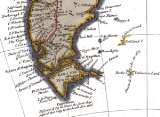
Beauchene Island
Encyclopedia

Falkland Islands
The Falkland Islands are an archipelago in the South Atlantic Ocean, located about from the coast of mainland South America. The archipelago consists of East Falkland, West Falkland and 776 lesser islands. The capital, Stanley, is on East Falkland...
, lying about 34 mi (54 km) south of Porpoise Point in Lafonia
Lafonia
Lafonia is a peninsula forming the southern part of East Falkland, the largest of the Falkland Islands.-Geography and geology:Shaped like the letter "E", it is joined to the northern part of the island by a 1.5-mile narrow isthmus; were this isthmus to be severed, Lafonia would be the third...
. It was discovered in 1701 by Jacques Gouin de Beauchêne
Jacques Gouin de Beauchene
Jacques Gouin de Beauchêne was a French explorer. His name is also spelled as Beauchesne. He was born in Saint-Malo in Brittany, and died there at 78 years of age....
in whose honour it was named.
Geography
Beauchene is the most isolated island of the Falkland archipelago. It is uninhabited, free of introduced predators and, because it is so remote, has been protected from disturbance. It is 172 hectares (425 acre) in area. The north of the island is covered in dense tussac with boulder beaches on the western coast and sloping up gently to about 30 metres (98.4 ft) in height. In the south of the island the land rises to around 70 metres (229.7 ft). There are higher cliffs on the eastern coast. "The southern quarter of the island is almost bare of vegetation."There is a natural anchorage on the east side of the island, but this can only be used in fair weather. However there is no resident population and visitors are not permitted on the island without the permission of the Falkland Islands Executive Committee. A typical example was a request that was made by Falklands Conservation
Falklands Conservation
Falklands Conservation is a charitable organisation formed to protect the wildlife and the natural environment of the Falkland Islands in the South Atlantic Ocean...
to make three visits in October 2010, January 2011 and March 2011 for the purpose of taking a bird census. In their application, it was noted that no people had set foot on the island since a visit by the Shallow Marine Survey Group (SMSG) in December 2009
History
Anthony de la RochéAnthony de la Roché
Anthony de la Roché, born sometime in the 17th century, was an English merchant born in London to a French Huguenot father and an English mother...
may have sighted Beauchene Island as early as April 1675. However, this is by no means certain; de la Roché had been rounding Cape Horn
Cape Horn
Cape Horn is the southernmost headland of the Tierra del Fuego archipelago of southern Chile, and is located on the small Hornos Island...
and was blown off course. What he visited is usually said to be South Georgia, which fits his descriptions better, particularly of high ice covered mountains and bays in one of which la Roché anchored for a fortnight (see the Seixas y Lovera narrative), but supporters of Argentina
Argentina
Argentina , officially the Argentine Republic , is the second largest country in South America by land area, after Brazil. It is constituted as a federation of 23 provinces and an autonomous city, Buenos Aires...
's claim to South Georgia more often claim it was Beauchene.
A while after its official discovery in 1701 by Jacques Gouin de Beauchêne
Jacques Gouin de Beauchene
Jacques Gouin de Beauchêne was a French explorer. His name is also spelled as Beauchesne. He was born in Saint-Malo in Brittany, and died there at 78 years of age....
, seal trappers tried to settle the island unsuccessfully.
In 1834, the American McArthur landed 100 people on the island, driving the local sea lions to extinction (they have since returned).
The island is currently uninhabited, but there the ruins of a group of houses built in the 1830s, on the west side of the island.
The first proper scientific expedition landed in 1951 by helicopter, staying for a month.
During the Falklands War, there was an Argentine wreck on a reef just south of the islands, and British soldiers lived for around four weeks there.
Flora and fauna
The island is a nature reserveNature reserve
A nature reserve is a protected area of importance for wildlife, flora, fauna or features of geological or other special interest, which is reserved and managed for conservation and to provide special opportunities for study or research...
. It is covered in tussac grass and is known for its colony of black-browed albatross
Black-browed Albatross
The Black-browed Albatross or Black-browed Mollymawk, Thalassarche melanophrys, is a large seabird of the albatross family Diomedeidae, and it is the most widespread and common albatross.-Taxonomy:...
es. A total of thirty species of bird have been recorded on the island including rockhopper penguin
Rockhopper penguin
The rockhopper penguins are three closely related taxa of crested penguins that have been traditionally treated as a single species and are sometimes split into two or three species. Not all experts agree on the classification of these penguins...
s. The coast is known for its cave
Cave
A cave or cavern is a natural underground space large enough for a human to enter. The term applies to natural cavities some part of which is in total darkness. The word cave also includes smaller spaces like rock shelters, sea caves, and grottos.Speleology is the science of exploration and study...
s and for its peat
Peat
Peat is an accumulation of partially decayed vegetation matter or histosol. Peat forms in wetland bogs, moors, muskegs, pocosins, mires, and peat swamp forests. Peat is harvested as an important source of fuel in certain parts of the world...
, which forms at around ten times the rate of anywhere else in the world. The process by which it forms so fast is not understood fully.

